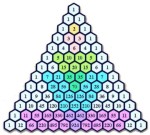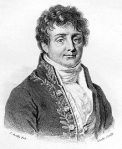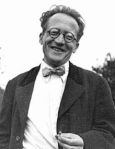The paper I wrote with Alfonso Farina and Matteo Sedehi about the link between the Tartaglia-Pascal triangle and quantum mechanics is now online (see here). This paper contains as a statement my theorem that provides a connection between the square root of a Wiener process and the Schrödinger equation that arose a lot of interest and much criticisms by some mathematicians (see here). So, it is worthwhile to tell how all this come about.
On fall 2011, Alfonso Farina called me as he had an open problem after he and his colleagues got published a paper on Signal, Image and Video Processing, a journal from Springer, where it was shown how the Tartaglia-Pascal triangle is deeply connected with diffusion and the Fourier equation.  The connection comes out from the
The connection comes out from the  binomial coefficients, the elements of the Tartaglia-Pascal triangle, that in some limit give a Gaussian and this Gaussian, in the continuum, is the solution of the Fourier equation of heat diffusion. This entails a deep connection with stochastic processes. Stochastic processes, for most people working in the area of radar and sensors, are essential to understand how these device measure through filtering theory. But, in the historic perspective Farina & al. put their paper, they were not able to get a proper connection for the Schrödinger equation, notwithstanding they recognized there is a deep formal analogy with the Fourier equation. This was the open question: How to connect Tartaglia-Pascal triangle and Schrödinger equation?
binomial coefficients, the elements of the Tartaglia-Pascal triangle, that in some limit give a Gaussian and this Gaussian, in the continuum, is the solution of the Fourier equation of heat diffusion. This entails a deep connection with stochastic processes. Stochastic processes, for most people working in the area of radar and sensors, are essential to understand how these device measure through filtering theory. But, in the historic perspective Farina & al. put their paper, they were not able to get a proper connection for the Schrödinger equation, notwithstanding they recognized there is a deep formal analogy with the Fourier equation. This was the open question: How to connect Tartaglia-Pascal triangle and Schrödinger equation?
People working in quantum physics are aware of the difficulties researchers have met to link stochastic processes a la Wiener and quantum mechanics. Indeed, skepticism is the main feeling of all of us about this matter. So, the question Alfonso put forward to me was not that easy. But Alfonso & al. paper contains also a possible answer: Just start from discrete and then go back to continuum. So, the analog of the heat equation is the Schrödinger equation for a free particle and its kernel and, indeed, the evolution of a Gaussian wave-packet can be managed on the discrete and gives back the binomial coefficient. What you get in this way are the square root of binomial coefficients.  So, the link with the Tartaglia-Pascal triangle is rather subtle in quantum mechanics and enters through a square root, reminiscent of the Dirac’s work and his greatest achievement, Dirac equation. This answered Alfonso’s question and in a way that was somewhat unexpected.
So, the link with the Tartaglia-Pascal triangle is rather subtle in quantum mechanics and enters through a square root, reminiscent of the Dirac’s work and his greatest achievement, Dirac equation. This answered Alfonso’s question and in a way that was somewhat unexpected.
Then, I thought that this connection could be deeper than what we had found. I tried to modify Itō calculus to consider fractional powers of a Wiener process. I posted my paper on arxiv and performed both experimental and numerical computations. All this confirms my theorem that the square root of a Wiener process has as a diffusion equation the Schrödinger equation. You can easily take the square root of a natural noise (I did it) or compute this on your preferred math software. It is just interesting that mathematicians never decided to cope with this and still claim that all this evidence does not exist, basing their claims on a theory that can be easily amended.
We have just thrown a seed in the earth. This is our main work. And we feel sure that very good fruits will come out. Thank you very much Alfonso and Matteo!
Farina, A., Frasca, M., & Sedehi, M. (2013). Solving Schrödinger equation via Tartaglia/Pascal triangle: a possible link between stochastic processing and quantum mechanics Signal, Image and Video Processing DOI: 10.1007/s11760-013-0473-y
Marco Frasca (2012). Quantum mechanics is the square root of a stochastic process arXiv arXiv: 1201.5091v2
Farina, A., Giompapa, S., Graziano, A., Liburdi, A., Ravanelli, M., & Zirilli, F. (2011). Tartaglia-Pascal’s triangle: a historical perspective with applications Signal, Image and Video Processing, 7 (1), 173-188 DOI: 10.1007/s11760-011-0228-6



 Posted by mfrasca
Posted by mfrasca 

